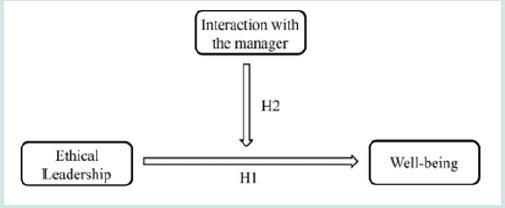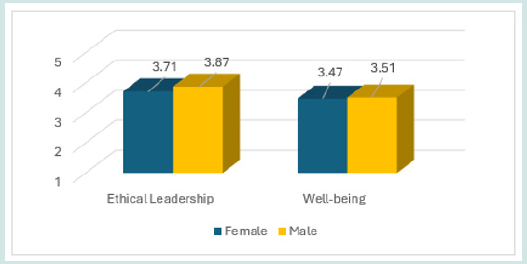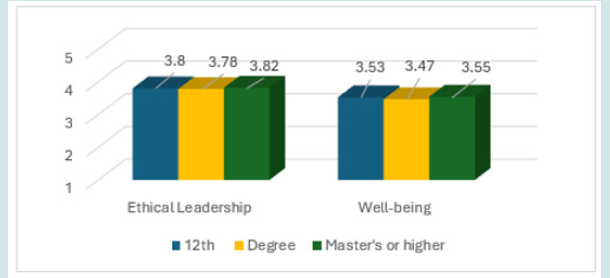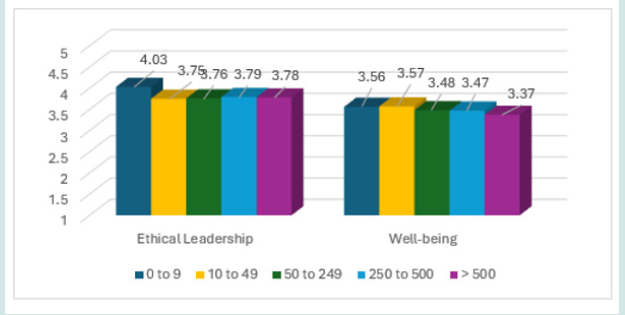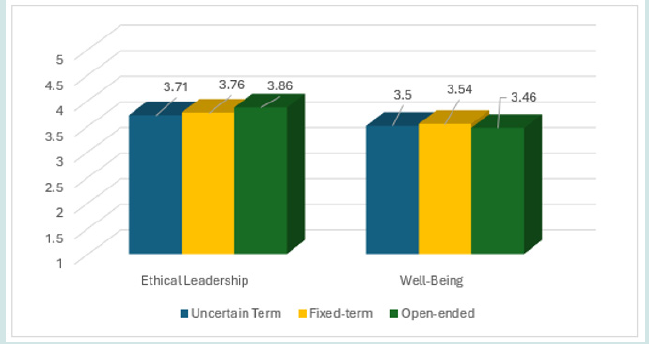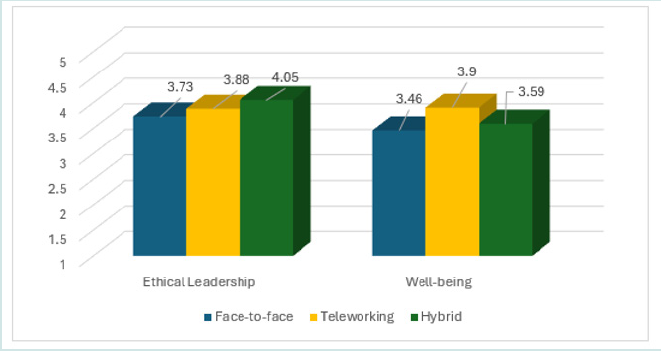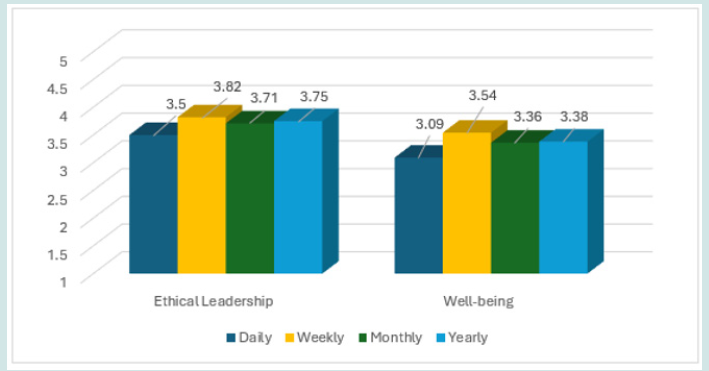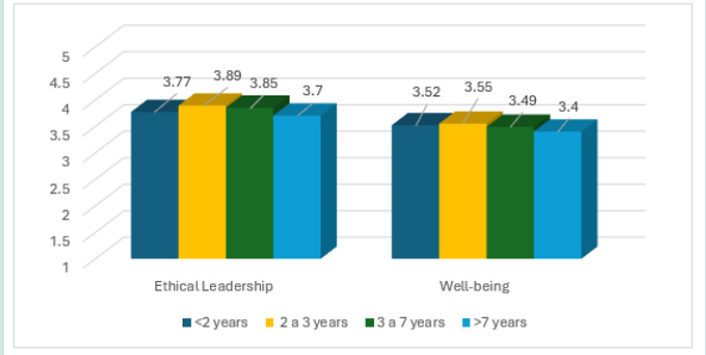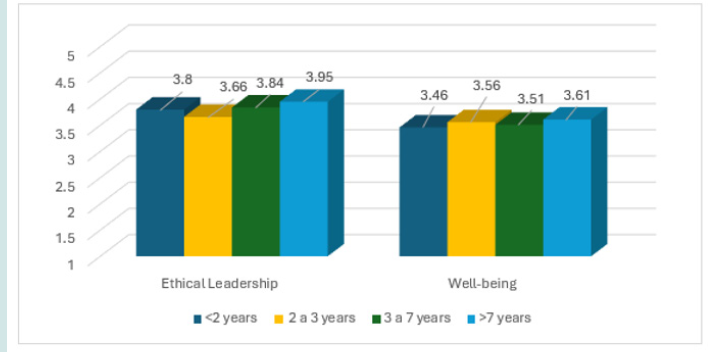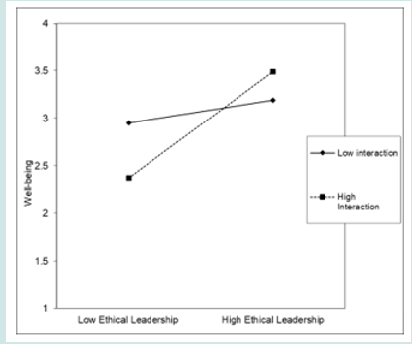
Lupine Publishers Group
Lupine Publishers
Menu
ISSN: 2641-1768
Reasearch ArticleOpen Access
Ethical Leadership and Employee Well-Being: The moderating effect of interaction with the manager Volume 8 - Issue 2
Dália Inocêncio1, Ivo Dias1 and Ana Palma-Moreira1,2*
- 1Faculdade de Ciências Sociais e Tecnologia, Universidade Europeia, Quinta do Bom Nome, Estr. da Correia 53, 1500-210 Lisboa, Portugal
- 2APPsyCI-Applied Psychology Research Center Capabilities & Inclusion, ISPA-Instituto Universitário, 1149-041 Lisboa, Portugal
Received: April 24, 2024; Published: May 02, 2024
Corresponding author: Ana Moreira, School of Psychology, ISPA-Instituto Universitário, Rua do Jardim do Tabaco 34, 1149-041 Lisboa, Portugal.
DOI: 10.32474/SJPBS.2024.08.000288
Abstract
The main objective of this research was to study the impact of ethical leadership on employee well-being and whether this relationship is moderated by interaction with the manager. The study sample consisted of 131 participants working in Portuguese organizations. The hypotheses were tested using SPSS and Macro Process. The results indicate that ethical leadership is positively and significantly associated with well-being and that interaction with the manager moderates this relationship. For participants with a high level of interaction with their manager, when compared to participants with a low level of interaction with their manager, ethical leadership is relevant to boosting their well-being. Interaction with the manager plays a crucial moderating role and can strengthen or weaken the relationship between ethical leadership and employee well-being. Therefore, for ethical leadership to reach its full potential, it is essential to ensure that interactions between leaders and employees are high quality and frequent.
Introduction
The organizational operation of human capital management is crucial to increasing profitability and productivity in the business areas to which companies are linked to guarantee the achievement of the goals set and greater sustainability, which implies making two essential cornerstones compatible: leadership style and the well-being of workers and collaborators. [1] argues that leadership is necessary in all types of organizations and human management functions, especially in companies. Studies on ethical leadership have looked at the significant role of ethics for leaders in all sectors, conceptualizing ethical leadership differently. The initial model includes the main dimensions of the ethical virtues of the leaders themselves and the activities they carry out to install them in followers [2].
This type of leadership is almost always open to criticism, i.e. the fact that the leader, according to research, possesses specific characteristics does not guarantee leadership success, despite the evidence that effective leaders are different from other people in certain vital aspects. The most apparent characteristics are motivation in the broad sense, i.e. this motivation must include achievement, drive, ambition, energy, tenacity and initiative; motivation for leadership, in the sense of possessing the desire to lead without, however, seeking power as an end, honesty and integrity; self-confidence associated with emotional stability; cognitive ability; and knowledge of the business. Concerning other less clear evidence of traits, such as charisma, creativity and flexibility, [3] believe that “key leader characteristics help the leader to acquire the necessary skills; formulate an organizational vision and an effective plan to pursue it; and take the necessary steps to implement the vision in reality” (p. 48). [4] have also focused on the study of happiness. However, they separate the concept into two elements: subjective, identified by standards of living, and objective, related to individuals’ psychological state. These two authors define well-being as “a multidimensional combination of three positive concepts: job satisfaction, job involvement, and affective organizational commitment” [4].
The following research questions emerged
- What is the impact of leadership on the well-being of an organization’s employees?
- Does interaction with the manager moderate the relationship between ethical leadership and employee well-being?
Therefore, the primary objective of this study is to comprehend the positive and significant impact of ethical leadership on employee well-being. We also seek to identify the moderation effect of interaction with managers on the relationship between ethical leadership and employee well-being.
Literature Review
Ethical Leadership
Ethics can be defined as a set of norms and values that determine the behaviour of individuals through psychological processes that drive ethical or unethical behaviour and how these human behaviours can be translated into actions that can be taken to create more ethical environments [5]. The concept of Ethical Leadership has acquired an increasing impact among researchers dedicated to the study of organizational behavior due to the moral and social crises that have arisen over the last two decades, which have had damaging effects both on companies and organizations, with the fall in the stock market of these companies, and at the national and international level, as a result of the relevance they had acquired, above all, due to the ineffectiveness of their leadership [2]. Ethical leadership can be defined as “the demonstration of normatively appropriate conduct through personal actions and interpersonal relationships. The promotion of such conduct to followers through two-way communication, reinforcement, and decision-making” (Brown, 2005). It is also “the process of influencing group activities to achieve goals in a socially responsible manner” [6].
This leadership concession implies two main roles in an ethical leader: the moral person and the moral manager. The role of the moral person refers to the leader’s ethical values. In contrast, the moral manager refers to the activities the leader undertakes to propose these ethical values to the followers. The definition above mentions three activities: communication, reinforcement and decision-making [6]. Ethical leadership is the art of leading people and making good decisions based on values such as justice, responsibility, trust, honesty, equality and respect. These values form the central basis of ethical leadership [7].
Well-Being
The concept of Employee Well-Being does not have a concise definition and differs according to the scholars who have carried out research on this subject. Despite its complexity, it focuses on two variables: the psychological well-being and the physical well-being of employees. The complexity lies in the fact that when carrying out their analyses, researchers mix up terms such as well-being and happiness in the scientific literature, considering them synonyms [8], and also because researchers treat well-being in different ways, such as happiness, satisfaction, state of mind, positive affect [9]. Some authors have also seen it as a subjective assessment of the quality of life. [8] claim that there is well-being at work when a person experiences personal expressiveness and self-realization; in other words, when they feel satisfied with their life, there will be a prevalence of positive affections over negative ones. These two researchers define well-being at work as the prevalence of positive emotions and the individual’s perception that they are expressing and developing their potential/skills and progressing towards their life goals. According to them, the concept includes both affective aspects, assessed by emotions and moods, and cognitive aspects, represented by achievement, encompassing the subjective and psychological well-being approaches [8].
Ethical Leadership and Well-being
Ethical leadership can undoubtedly be considered one of the factors that contribute to workers’ well-being [10]. Well-being associated with work is directly related to situations linked to positive emotions, happiness and satisfaction at work [11]. In other words, when workers experience certain positive emotions, they can perform their duties with greater motivation, and this performance will translate into greater productivity.
The leader plays a decisive role in workers’ perception of how they carry out their work. Kalshoven and Boon (2012) consider that ethical leaders should be expected to use communication and rewards rather than punishment to positively shape and influence employee behaviour, in the same vein as Kalshoven and Boon (2012). [12, 13] consider that by establishing quality relationships, they provide employees with a working environment where they can feel more secure and supported, which undoubtedly creates conditions that foster a positive emotional experience, which translates into a sense of well-being for employees (Bedi et al., 2016). The existence of ethical leaders, in addition to the feeling of trust, which in itself is one of the greatest advantages associated with this type of leadership [12], can also lead to greater employee involvement and commitment, both to the job they do and to the organization they are part of. By reducing their levels of exhaustion and stress, employees feel more able to increase their performance.
Bearing in mind that employees are increasingly a precious asset for an organization, without whom it will not be able to effectively achieve its objectives and goals [14], it is imperative to continue to focus on well-being, satisfaction and trust, which will provide greater motivation, commitment and engagement of employees in the performance of their duties, which translates into higher levels of productivity and greater and better efficiency and effectiveness in organizational terms.
The ethical leader, who has values and principles such as justice and honesty, contributes to the well-being of their employees by increasing their levels of trust and, concomitantly, a more significant commitment on their part to their work. This more fruitful relationship is illustrative of employee well-being [14].
The following hypotheses are thus formulated:
H1: Ethical leadership has a positive and significant effect on employee well-being.
H2: Interaction with manager has a moderating effect on the relationship between ethical leadership and employee wellbeing.
The hypotheses formulated are summarized in the following research model (Figure 1)
Methods
Data collection procedure
In this study, 131 subjects who worked for companies in Portugal participated voluntarily. Data was collected electronically, and the questionnaire was made available on the Google Forms platform and shared on social and personal contact networks. The questionnaire consists of a general introduction explaining the aim of the study and the prerequisites for participation, reinforcing that the data collected is solely and exclusively for academic purposes and that all participants are confidential and anonymous. The questionnaire consists of 3 more sections, starting with the scales for the variables under study (ethical leadership and leadership and well-being) and then the sociodemographic data; the sample was collected during 2023/2024.
Participants
This study’s sample consisted of 131 participants aged between 17 and 58 (M= 29.14; SD= 6.878). Subsequently, age was transformed into age classes to work with the data more concisely, and three age classes were formed. It was found that among the participants, 66 (50.4%) were male and 65 (49.6%) females, with no respondent answering the “Other” option. Regarding educational qualifications, 16 (12.2%) had a 12th-grade degree or less, 92 (70.2%) had a bachelor’s degree, and 23 (17.6%) had a master’s degree or higher. Regarding the sector in which they work, 96 (72.5%) are in the private sector 36 (27.5%) in the public sector, 14 (10.7%) work in a company with between 0 and 9 employees, 41 (31.3%) in a company with between 10 and 49, 36 (27.6%) in a company with between 50 and 249, 11 (8.4%) between 250 and 500 and 29 (22.1%) more than 500 employees. Concerning the type of contract, 37 (28.2) are for an uncertain term, 35 (26.7%) for a fixed term and 59 (45.0%) for an indefinite term. When asked about the type of work, 103 (78.6%) answered face-to-face, 4 (3.1%) answered teleworking, and 24 (18.3%) answered hybrid. Regarding the frequency with which they interact with their direct manager, 1 (0.8%) answered daily, 99 (75.6%) answered weekly, 23 (17.65) answered monthly and 8 (6.1%) annually. In terms of seniority in the company, 56 people (42.7%) had been with the company for less than one year, 16 (12.2%) for between 1 and 2 years, 30 (22.9%) for between 2 and 5 years and 28 (21.4%) for almost five years. Regarding the length of time they have worked with their manager, 72 (55.0%) people said they had worked for less than one year, 25 (19.1%) had worked for between 1 and 2 years, 24 (18.3%) had worked for between 2 and 5 years and 10 (7.6%) had worked for almost five years.
Data analysis procedure
After collecting the data, it was processed by analysing the quality and metrics of the instruments. To study the internal consistency of the instruments used in this study, SPSS STATISTICS version 29 was used. The internal consistency of each scale was analyzed by calculating Cronbach’s alpha, where the value should vary between “0” and “1” without assuming negative values [15]. It should be higher than .70, which is the minimum acceptable in organizational studies [16]. Concerning the sensitivity study, the different measures of central tendency, dispersion and distribution were calculated for the different items of the scales used, thus carrying out the normality study for all the items and the various scales. Hypothesis 1 was tested using simple linear regression, and the moderating effect (hypothesis 2) was tested using the Macro Process developed by [17].
Instruments
Ethical Leadership - was analyzed based on the leadership scale by [18]. The response to the ethical leadership items or variables uses a Likert-type evaluation scale, ranging from “Strongly disagree” (1) to “Strongly agree” (5). This scale consists of 10 items, including two types of ethical leader behavior: justice and how they make decisions. This instrument has good internal consistency with a Cronbach’s alpha of 0.90. Well-being - was measured using the 32- item well-being at work scale developed by [19]. This instrument assumes that the work context is an environment surrounded by emotions, fulfilment and expressiveness, which can contribute to the well-being of workers. The response to the items or variables of workers’ well-being is based on a Likert-type evaluation scale, ranging from “Very rarely or never” (1) to “Very often or always” (5). This instrument has good internal consistency with a Cronbach’s alpha of 0.87.
Results
Descriptive statistics of the variables under study
To understand the position of the answers given by the participants in this study, descriptive statistics were carried out on the variables under study using the student’s t-test for one sample. The results show that the participants in this study perceive ethical leadership and well-being significantly above the scale’s central point (3), which indicates that they perceive their leaders as behaving ethically and feel high levels of well-being (Table 1).
Effect of sociodemographic variables on the variables under study
We then calculated the mean to study the distribution of the variables under study according to the sociodemographic variables. Male participants have a slightly higher perception of ethical leadership and well-being than female participants (Figure 2).
Participants with a master’s degree or higher perceive ethical leadership and well-being more positively than those with a bachelor’s degree (Figure 3).
Participants working in private companies have a slightly higher perception of ethical leadership and well-being than public companies (Figure 4).
The participants with the highest perception of ethical leadership are those in smaller companies (0-9 employees), and those with the highest perception of well-being are those in medium-sized companies (10-49 employees) (Figure 5).
Participants with open-ended contracts have a higher perception of ethical leadership, and fixed-term participants have a higher perception of well-being (Figure 6).
Participants who work in a hybrid way have the highest perception of ethical leadership and those who work remotely have a higher perception of well-being (Figure 7).
Participants who interact with their manager weekly have a higher perception of ethical leadership and well-being than those who interact daily (Figure 8).
Participants who have been with the organization for 2 to 3 years have a higher perception of ethical leadership and well-being than those who have been with it for more than seven years (Figure 9).
Participants who have had the same manager for a longer time have a higher perception of ethical leadership and well-being regarding others (Figure 10).
Association between the variables under study
The association between the variables under study was tested using Pearson correlations.
The results show that ethical leadership is positively and significantly associated with well-being, i.e. the more ethical the leader’s behavior, the higher the levels of well-being among employees (Table 2).
H2: Interaction with manager has a moderating effect on the relationship between ethical leadership and employee well-being.
Hypothesis
H1: Ethical leadership has a positive and significant effect on employee well-being.
To test hypothesis 1, a simple linear regression was performed.
The results show that ethical leadership positively and significantly affects employee well-being (β = .47, p < .001). The model explains 23% of the variability in well-being. The model is statistically significant (F (1, 129) = 37.37, p < .001) (Table 3).
This hypothesis was confirmed.
H2: Interaction with manager has a moderating effect on the relationship between ethical leadership and employee well-being.
As this hypothesis presupposes an interaction effect, it was tested using the Macro Process developed by [17]. The results show that interaction with the manager moderates the relationship between ethical leadership and well-being (B = .22, p = .045). The model explains 26% of the variability in well-being (Table 4)
For participants with high interaction with their manager, ethical leadership becomes relevant to boosting their well-being (Figure 11).
References
- Chiavenato I (2000) Administración de recursos humanos. 5ta. Edición. Ed. Mc.
- Brown ME, Treviño LK (2006) Ethical leadership: A review and future directions. The leadership quarterly, 17(6): 595-616.
- Kirkpatrick SA, Locke EA (1991) Leadership: Do Traits Matter? Academy of Management Executive. 5: 48-60.
- Siqueira MM, Padovam VAR (2008) Theoretical basis of subjective well-being, psychological well-being and well-being at work. Psychology: Theory and Research, 24(2): 201–209.
- Fletcher GJ, Simpson JA, Campbell L, Overall NC (2015) Pair-bonding, romantic love, and evolution: The curious case of Homo sapiens. Perspectives on psychological science, 10(1): 20-36.
- Kalshoven K, Den Hartog DN, De Hoogh AHB (2011) Ethical leader behavior and Big Five factors of personality. Journal of Business Ethics, 100(2): 349–366.
- King SM, Firestone S, Henkel, H, Moore B (2023) Ethical Leadership: Descriptive Literature Review of the Diverse Influence and Development of Ethics upon Public Sector and Military Leaders, Followers, and Organizations. Journal of Values-Based Leadership 16(2).
- Paschoal T, Tamayo A (2008) Construction and validation of the work well-being scale. Psychol. evaluation, 7(1): 11-22.
- Albuquerque AS, Tróccoli BT (2004) Development of a Subjective Well-Being Scale. Psych.Theor. And Res., 20(2): 153–164.
- Kalshoven K, Boon CT (2012) Ethical leadership, employee well-being, and helping: The moderating role of human resource management. Journal of Personnel Psychology, 11(1): 60–68.
- Grebner S, Elfering A, Semmer NK (2010) The success resource model of job stress. In: PL Perrewé, DC Ganster (Eds.): New developments in theoretical and conceptual approaches to job stress. Emerald Group Publishing, pp: 61–108.
- Chughtai A, Byrne M, Flood B (2015) Linking Ethical Leadership to Employee Well-Being: The Role of Trust in Supervisor. J Bus Ethics ,128: 653–663.
- Rivers J, Thompson N, Jeske D (2018) Dedicated but exhausted? The role of ethical leadership for employee wellbeing in UK student unions. Journal of Human Resource Management, XXI (2): 16-27.
- Bello SM (2012) Impact of Ethical Leadership on Employee Job Performance. International Journal of Business and Social Science, 3: 228-236.
- Hill M, Hill A (2005) Questionnaire Research. 2nd Ed. Edições Sílabo.
- Bryman A, Cramer D (2003) Data analysis in social sciences: introduction to techniques using SPSS for Windows. 3rd ed. Oeiras: Celta.
- Hayes AF (2013) Introduction to Mediation, Moderation, and Conditional Process Analysis: A Regression-Based Approach. London & New York: Guilford Press, pp: 34-40.
- Brown ME, Treviño LK, Harrison DA (2005) Ethical leadership: A social learning perspective for construct development and testing. Organizational Behavior and Human Decision Processes,97(2): 117-134.
- Carneiro LL, Bastos AVB (2023) Well-being at work scale (WBWS): Gathering empirical evidence from different interpretation strategies. Quaderns de Psicologia, 25 (1): e1729.
- Glynn M, Jamerson H (2006) Principled Leadership: A Framework for Action. In: Hess and Cameron KS (Eds.) Leading Values: Positivity, Virtue, and High Performance, pp.151-171.
- Neves P, Story J (2015) Ethical Leadership and Reputation: Combined Indirect Effects on Organizational Deviance. Journal of Business Ethics, 127(1): 165-176.

Top Editors
-

Mark E Smith
Bio chemistry
University of Texas Medical Branch, USA -

Lawrence A Presley
Department of Criminal Justice
Liberty University, USA -

Thomas W Miller
Department of Psychiatry
University of Kentucky, USA -

Gjumrakch Aliev
Department of Medicine
Gally International Biomedical Research & Consulting LLC, USA -

Christopher Bryant
Department of Urbanisation and Agricultural
Montreal university, USA -

Robert William Frare
Oral & Maxillofacial Pathology
New York University, USA -

Rudolph Modesto Navari
Gastroenterology and Hepatology
University of Alabama, UK -

Andrew Hague
Department of Medicine
Universities of Bradford, UK -

George Gregory Buttigieg
Maltese College of Obstetrics and Gynaecology, Europe -

Chen-Hsiung Yeh
Oncology
Circulogene Theranostics, England -
.png)
Emilio Bucio-Carrillo
Radiation Chemistry
National University of Mexico, USA -
.jpg)
Casey J Grenier
Analytical Chemistry
Wentworth Institute of Technology, USA -
Hany Atalah
Minimally Invasive Surgery
Mercer University school of Medicine, USA -

Abu-Hussein Muhamad
Pediatric Dentistry
University of Athens , Greece

The annual scholar awards from Lupine Publishers honor a selected number Read More...




